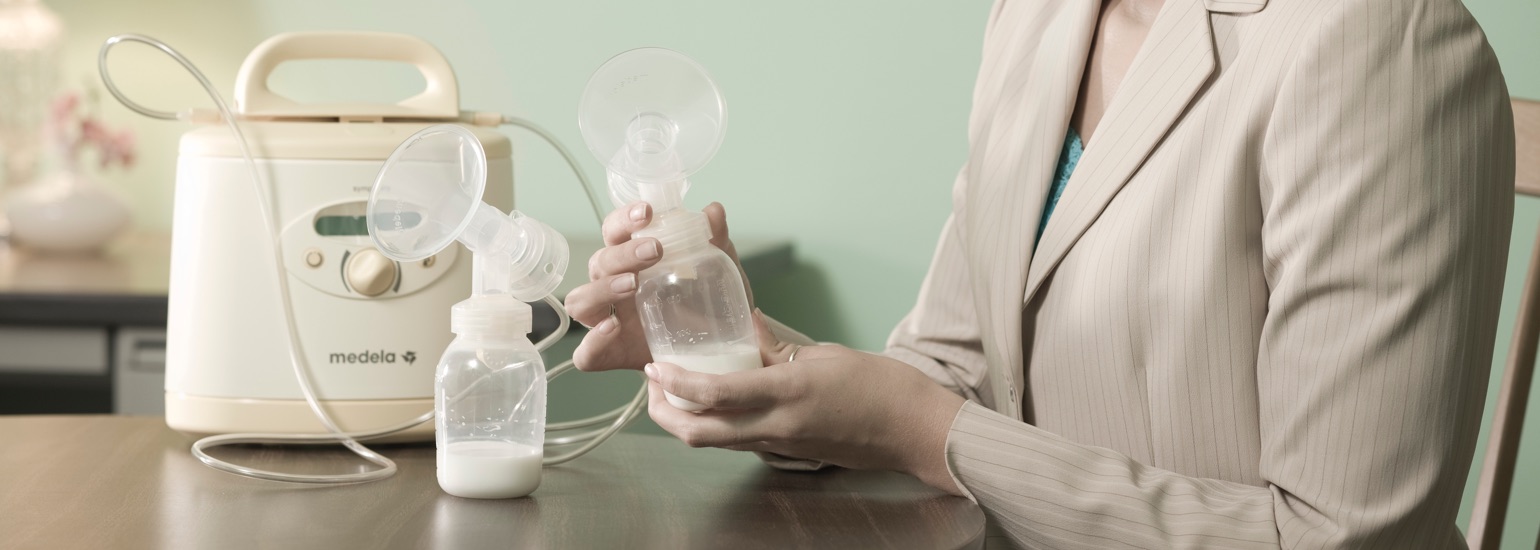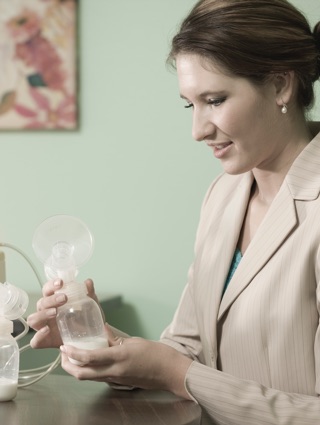Breastfeeding Support 24/7: 855-550-6667
Find a Place and Time to Pump
Did you know that your right to pump at work is protected by law? To make it a little easier, a Federal regulation called the PUMP Act (2022) protects the rights of most mothers to express milk in the workplace. Employers must provide reasonable time and a private space – not a bathroom – that is free from intrusion and available when needed for up to 1 year after your baby’s birth.
Where to Pump at Work
- Talk to your employer and look for a private place. If there’s not one, look around for a space that you are willing to use. The space can also be used for other things, but it should not be a bathroom and should be available anytime that you need to use it.
- Tips for using an office file room or storage closet: If the door doesn’t lock, hang a sign outside your door when you are pumping or ask to have a lock installed.
- Tips for using a cubicle: Use a shower curtain rod, a wooden dowel, or spring clamps from a hardware store to hang a large curtain outside your cubicle when you need to pump.
- Tips for creating a space: Room dividers or partitions can be used to make a quick pump room. You can even use a pop-up utility or shower tent if there are no other choices.
Still can’t find a space? Don’t worry. There is a solution for just about any setting. More ideas for you and your employer are available from the Texas Mother-Friendly Worksite initiative.
Employers are required to support breastfeeding women
In Texas, both federal and state laws ensure nursing moms are given the right to pump their breastmilk at most workplaces.
When to Pump: Planning a Schedule
- Don’t wait until your breasts get full before pumping. As a general guideline, you’ll need to pump the same number of times that you have been breastfeeding at home, or once for each feeding that your baby has while you are apart. Usually this is every two to three hours if your baby is between birth to 6 months and every three to four hours if your baby is 6 months or older.
- Most moms will need to use their morning and afternoon break times and part of their lunch hour to express breastmilk. If you don’t have usual break times, talk to your supervisor about scheduling times for breastmilk expression breaks.With a double-sided electric pump, each pumping session will take about 15 to 20 minutes. You will also need to factor in time to get to and from the milk-expression space and to wash your hands and equipment.
- With a double-sided electric pump, each pumping session will take about 15 to 20 minutes. You will also need to factor in time to get to and from the milk-expression space and to wash your hands and equipment.
Typical Breastfeeding Schedule
7 A.M.
Mom breastfeeds her baby just before heading to work.
10 A.M.
Mom pumps milk during a midmorning break.
12:30 A.M.
Mom pumps milk during lunch.
3 P.M.
Mom pumps milk during afternoon break.
5:30 P.M.
Mom breastfeeds her baby at home or at child care.
Help—How Do I Get More Milk?
- If you normally pump for 10 minutes, go for 15 or 20 for several sessions. Even if you don’t see more milk right away, the extra time will stimulate your breasts to increase production.
- Pump for 10 minutes, massage both breasts and wait a few minutes, then pump for 10 more minutes, massage both breasts and wait a few minutes, then pump for 10 more minutes.
- Pump more often. Add in another pumping session, either right before you go to bed or first thing after waking up. You can also pump one breast while feeding your baby on the other.
- Sleep more. As much as possible, make sure you are getting a good night’s rest and napping on the weekends.
Expert Tip
“Most moms don’t need a freezer full of milk. Having about 5 days’ worth of extra milk in your freezer is plenty in case you notice a temporary dip in your supply when you start back to work.”
Michelle P. WIC IBCLC
Just in Case: How to Hand-Express Your Milk
Sometimes the unexpected happens. Your electric pump fails or you leave a part of the pump at home. On days like this, you’ll be glad to know how to hand-express your milk. Plus, using hand-expression along with pumping can increase the amount of milk you are able to store for your baby. Here’s how:
- Wash your hands.
- Use a clean container with a wide opening to collect your milk.
- Place a warm washcloth on your breasts to help your milk flow.
- Massage your breast to help increase the amount of milk you express. Do this by placing one hand under your breast for support. Apply gentle pressure, using a circular motion with your other hand. Massage from several starting points, always working from the chest toward the nipple. Gently shaking your breasts while leaning forward can also help get your milk flowing.
- Hold the clean container near your breast. With your other hand, place your fingers and thumb about one to two inches away from the base of your nipple. Press IN toward your ribs, SQUEEZE gently into the center of your breast, then RELAX your hand, and REPEAT. The milk will not flow quickly at first, but keep going and your milk should begin to drip.
- Alternate between the right and left breast often, and rotate the placement of your fingers and thumb around your nipple to empty all areas of the breast. Expressing your milk gets easier with practice. Don’t be discouraged if you can only express a small amount in the first few days.
Need help? Check out this illustrated demonstration of hand-expression.




